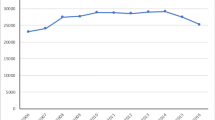Abstract
Introduction and hypothesis
Although urinary incontinence surgery has potential benefits such as preventing de novo stress urinary incontinence in women undergoing pelvic organ prolapse (POP) surgery, it comes with the potential cost of overtreatment and complications. We compared future surgery rates in a population cohort of women undergoing vaginal pelvic organ prolapse surgery.
Methods
All women undergoing POP repair in California from 2005 to 2011 were identified from the Office of Statewide Health Planning and Development databases. Rates of repeat surgery in those with and without concomitant urethral sling procedures were compared. To control for confounding effects, multivariate mixed effects logistic regression models were constructed to compare each woman’s individualized risk of undergoing either sling revision surgery or future incontinence surgery.
Results
In the cohort, 38,456 underwent a sling procedure at the time of POP repair and 42,858 did not. The future surgery rate was higher for sling-related complications in the POP + sling cohort compared with future incontinence surgery in the POP alone cohort (3.5% versus 3.0% respectively, p < 0.001). The difference persisted in multivariate modeling, where most women (60%) are at a higher risk of requiring sling revision surgery compared with needing a future primary incontinence procedure (40%).
Conclusions
Women who undergo vaginal prolapse repair without an incontinence procedure are at a low risk of future incontinence surgery. Women without urinary incontinence who are considering vaginal POP surgery should be informed of the risks and benefits of including a sling procedure.


Similar content being viewed by others
References
Chaikin DC, Groutz A, Blaivas JG. Predicting the need for anti-incontinence surgery in continent women undergoing repair of severe urogenital prolapse. J Urol. 2000;163:531–4.
Klutke JJ, Ramos S. Urodynamic outcome after surgery for severe prolapse and potential stress incontinence. Am J Obstet Gynecol. 2000;182:1378–81.
Visco AG, Brubaker L, Nygaard I, et al. The role of preoperative urodynamic testing in stress-continent women undergoing sacrocolpopexy: the Colpopexy and urinary reduction efforts (CARE) randomized surgical trial. Int Urogynecol J Pelvic Floor Dysfunct. 2008;19:607–14.
Brubaker L, Cundiff GW, Fine P, et al. Abdominal sacrocolpopexy with Burch colposuspension to reduce urinary stress incontinence. N Engl J Med. 2006;354:1557–66.
Wei JT, Nygaard I, Richter HE, et al. A midurethral sling to reduce incontinence after vaginal prolapse repair. N Engl J Med. 2012;366:2358–67.
Jonsson Funk M, Levin PJ, Wu JM. Trends in the surgical management of stress urinary incontinence. Obstet Gynecol. 2012;119:845–51.
Wu JM, Kawasaki A, Hundley AF, Dieter AA, Myers ER, Sung VW. Predicting the number of women who will undergo incontinence and prolapse surgery, 2010 to 2050. Am J Obstet Gynecol. 2011;205:230.e1–5.
Jonsson Funk M, Siddiqui NY, Pate V, Amundsen CL, Wu JM. Sling revision/removal for mesh erosion and urinary retention: long-term risk and predictors. Am J Obstet Gynecol. 2013;208:73 e71–7.
Syan R, Dallas KB, Sohlberg E, Rogo-Gupta L, Elliott CS, Enemchukwu EA. Rates and risk factors for future stress urinary incontinence surgery after pelvic organ prolapse repair in a large population-based cohort in California. Urology. 2019;123:81–6.
Iglesia CB. Vaginal prolapse repair—place midurethral sling now or later? N Engl J Med. 2012;366:2422–4.
Van der Ploeg JM, van der Steen A, Zwolsman S, van der Vaart CH, Roovers J. Prolapse surgery with or without incontinence procedure: a systematic review and meta-analysis. BJOG. 2018;125:289–97.
Chughtai B, Barber MD, Mao J, Forde JC, Normand ST, Sedrakyan A. Association between the amount of vaginal mesh used with mesh erosions and repeated surgery after repairing pelvic organ prolapse and stress urinary incontinence. JAMA Surg. 2017;152:257–63.
Richardson ML, Elliott CS, Shaw JG, Comiter CV, Chen B, Sokol ER. To sling or not to sling at time of abdominal sacrocolpopexy: a cost-effectiveness analysis. J Urol. 2013;190:1306–12.
Richter HE, Albo ME, Zyczynski HM, et al. Retropubic versus transobturator midurethral slings for stress incontinence. N Engl J Med. 2010;362:2066–76.
Jelovsek JE, Chagin K, Brubaker L, et al. A model for predicting the risk of de novo stress urinary incontinence in women undergoing pelvic organ prolapse surgery. Obstet Gynecol. 2014;123:279–87.
Ross JH, Carter-Brooks CM, Ruppert KM, Giugale LE, Shepherd JP, Zyczynski HM. Assessing the performance of the de novo postoperative stress urinary incontinence calculator. Female Pelvic Med Reconstr Surg 2019. https://doi.org/10.1097/SPV.0000000000000717.
Davenport MT, Sokol ER, Comiter CV, Elliott CS. Does the degree of cystocele predict De novo stress urinary incontinence after prolapse repair? Further analysis of the Colpopexy and urinary reduction efforts trial. Female Pelvic Med Reconstr Surg 2017;24(4):292–4.
Rogo-Gupta L, Litwin MS, Saigal CS, Anger JT. Trends in the surgical management of stress urinary incontinence among female Medicare beneficiaries, 2002–2007. Urology. 2013;82:38–41.
Welk B, Al-Hothi H, Winick-Ng J. Removal or revision of vaginal mesh used for the treatment of stress urinary incontinence. JAMA Surg. 2015;150:1167–75.
Ballert KN, Biggs GY, Isenalumhe A Jr, Rosenblum N, Nitti VW. Managing the urethra at transvaginal pelvic organ prolapse repair: a urodynamic approach. J Urol. 2009;181:679–84.
Author information
Authors and Affiliations
Contributions
K.D.: project development, data collection, manuscript writing; L.R.G.: project development, data collection, manuscript writing; R.S. project development, manuscript writing; E.E. project development, manuscript writing; C.S.E. project development, data collection, manuscript writing.
Corresponding author
Ethics declarations
Study is exempt from institutional board review as it went through State of California Protection of Human Subjects.
Conflicts of interest
None.
Additional information
Publisher’s note
Springer Nature remains neutral with regard to jurisdictional claims in published maps and institutional affiliations.
Supported by the Valley Medical Foundation
Appendix
Appendix
Rights and permissions
About this article
Cite this article
Dallas, K., Rogo-Gupta, L., Syan, R. et al. Balancing the possibility of needing a future incontinence procedure versus a future urethral sling revision surgery: a tradeoff analysis for continent women undergoing pelvic organ prolapse surgery. Int Urogynecol J 31, 1141–1150 (2020). https://doi.org/10.1007/s00192-020-04226-3
Received:
Accepted:
Published:
Issue Date:
DOI: https://doi.org/10.1007/s00192-020-04226-3




